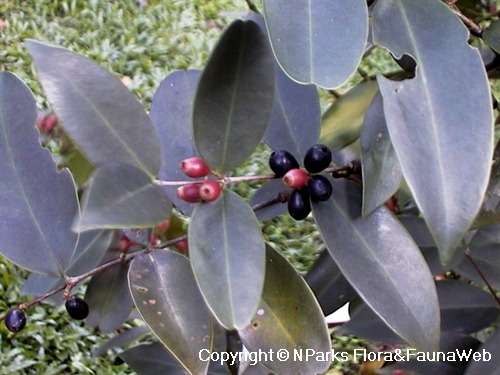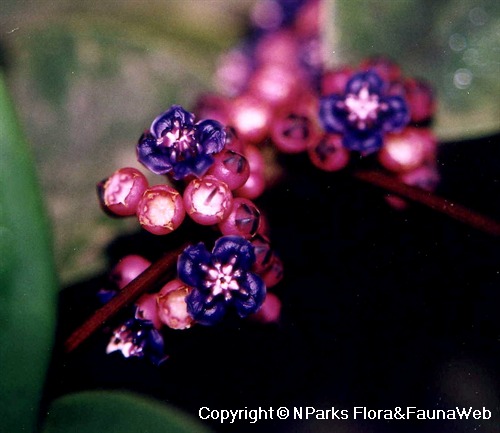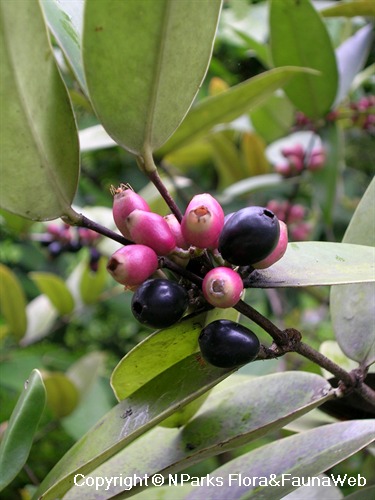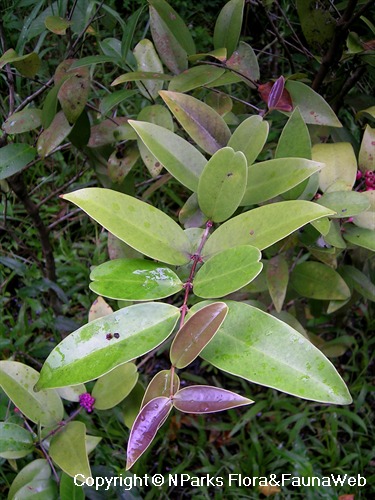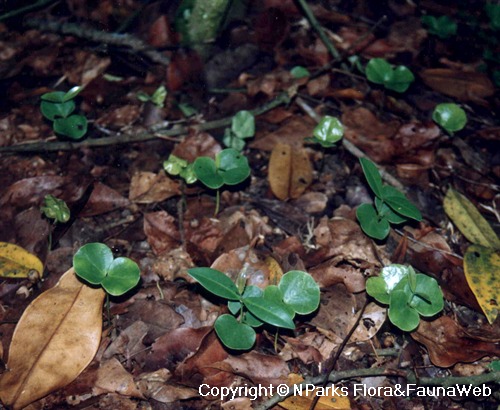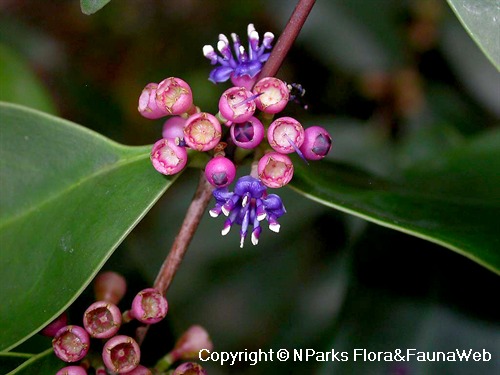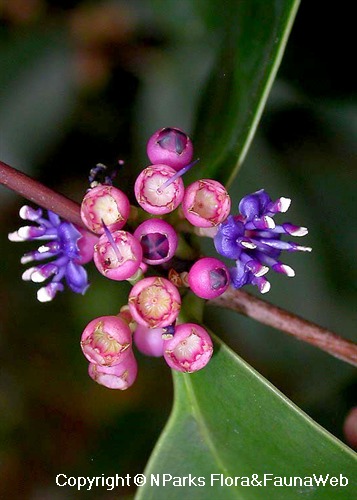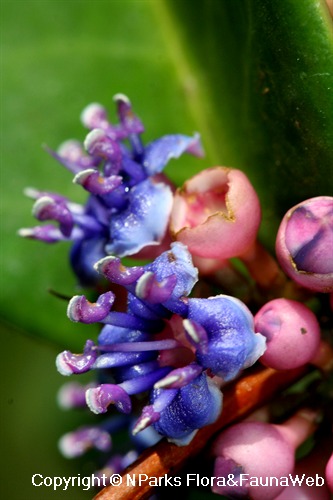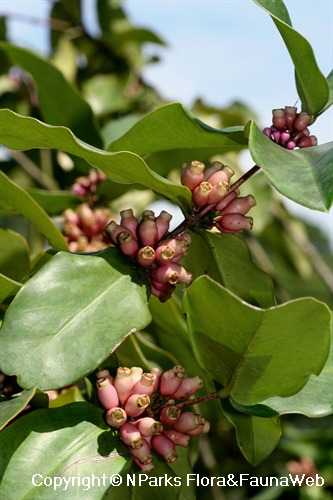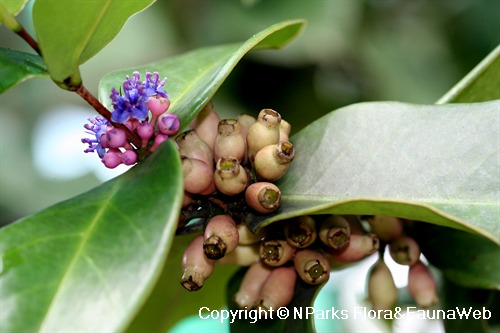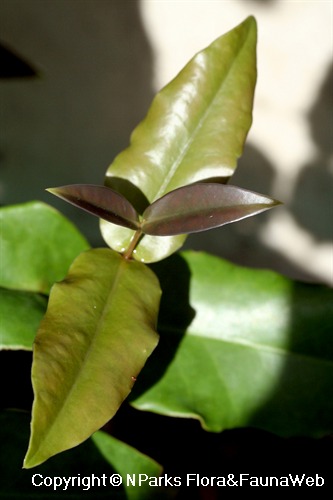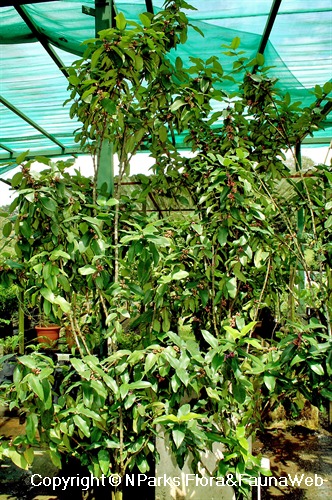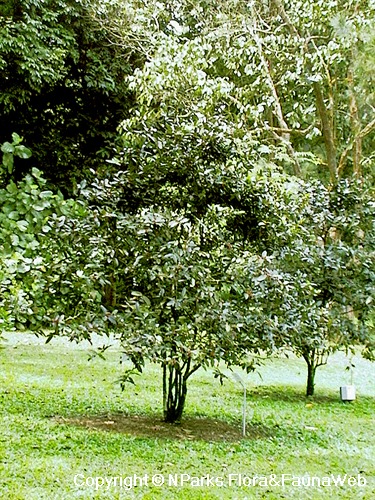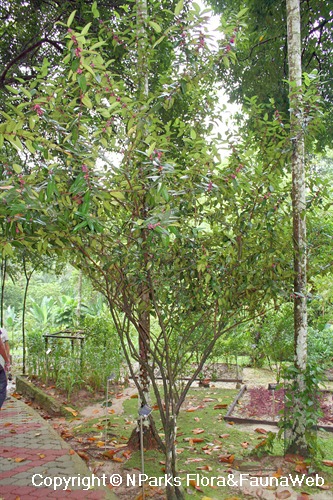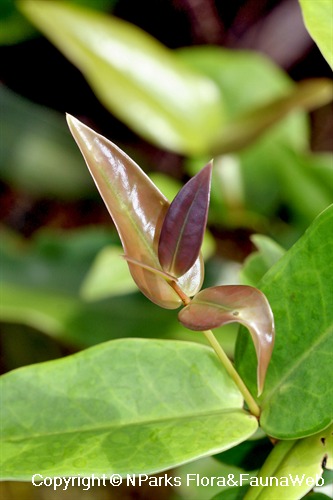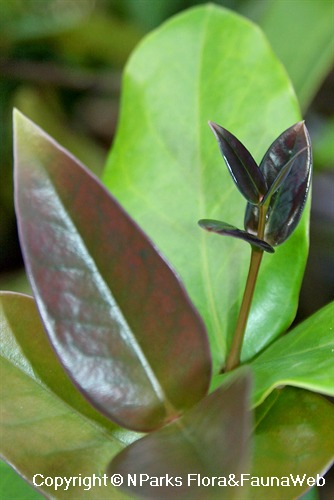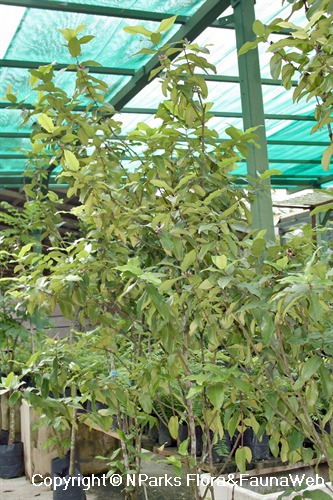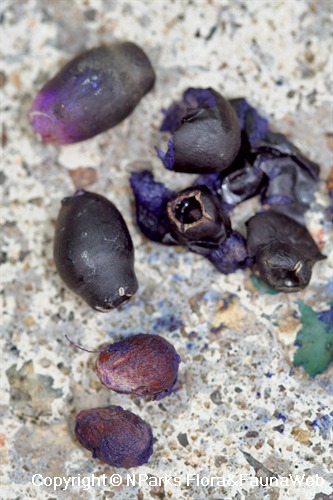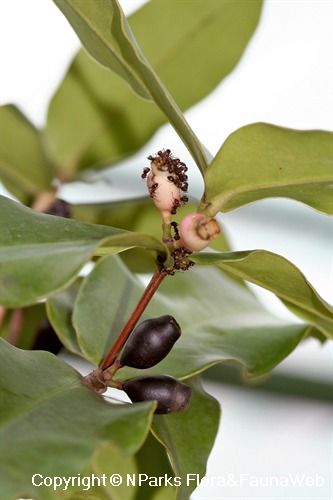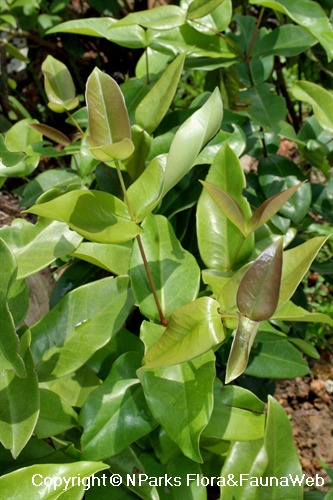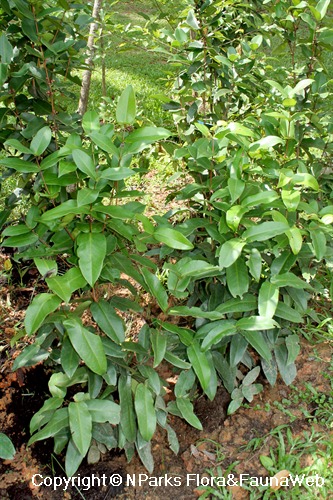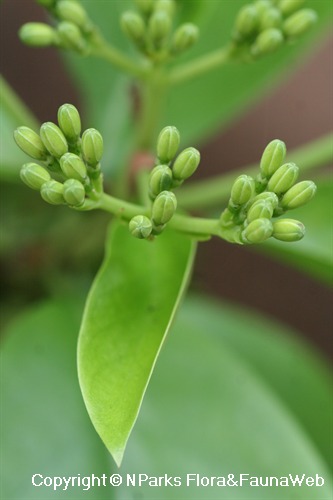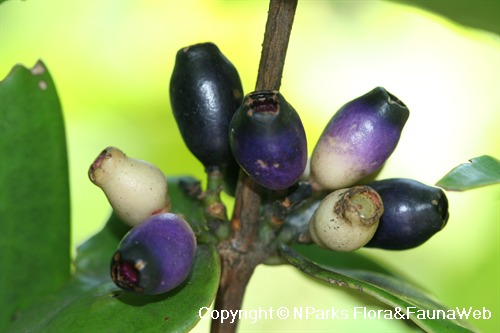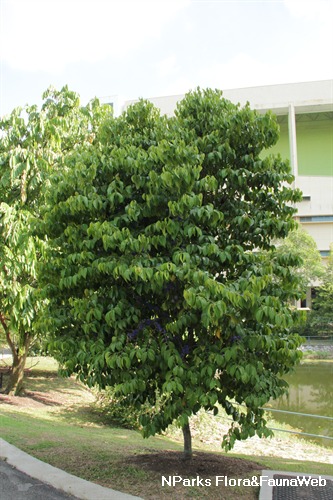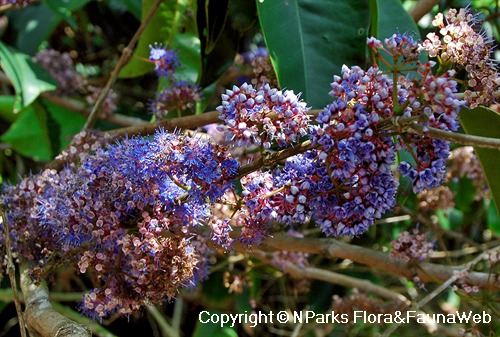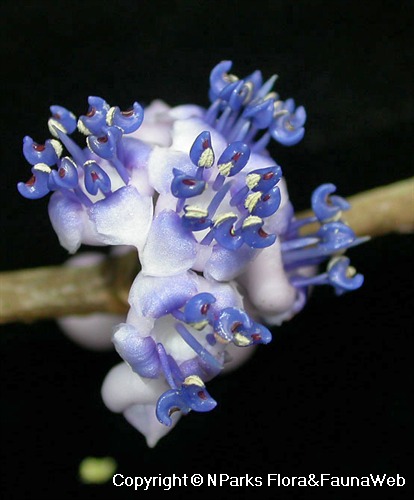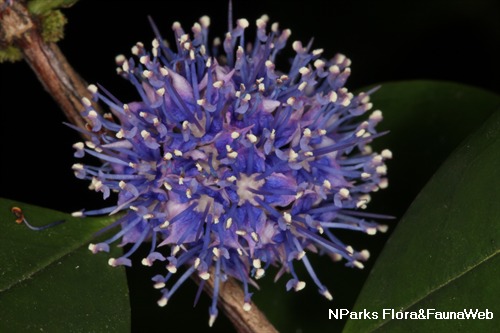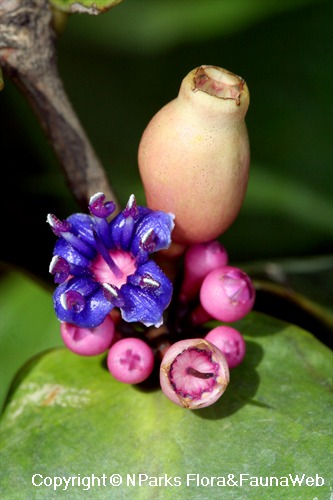
Back
Memecylon coeruleum Jack
| Family Name: | Melastomataceae |
| Synonyms: | Memecylon caeruleum var. floribundum, Memecylon cyanocarpum, Memecylon cordatum, Memecylon grande, Memecylon manillanum, Memecylon lutescens, Memecylon floribundum, Memecylon caeruleum |
| Common Name: | Nipis Kulik, Blue Strawberry Flowers, Javanese Nipis, Api-api Hutan, Delek-delek Jambu, Delek Jamu Putih, 天蓝谷木, 美锡兰树 |
Name
Classifications and Characteristics
| Plant Division | Angiosperms (Flowering Seed Plants) (Dicotyledon) |
|---|---|
| Plant Growth Form | Shrub, Tree (Small (6m-15m), Shrubby (1m-5m)) |
| Lifespan (in Singapore) | Perennial |
| Mode of Nutrition | Autotrophic |
| Plant Shape | Shrubby |
| Maximum Height | 3 m to 12 m |
Biogeography
| Native Distribution | The coasts of mainland Southeast Asia, the Philippines, and throughout the Malay Archipelago to New Guinea |
|---|---|
| Native Habitat | Terrestrial (Primary Rainforest, Secondary Rainforest, Monsoon Forest, Temperate Forest, Coastal Forest), Shoreline (Sandy Beach) |
| Preferred Climate Zone | Tropical, Sub-Tropical / Monsoonal, Temperate |
| Local Conservation Status | Non-native (Spontaneous (Casual)) |
Description and Ethnobotany
| Growth Form | It is a big shrub, or small tree with broadly-conical crown, usually up to 6m under cultivation, reaching 10-12m height in the wild. |
|---|---|
| Foliage | Its opposite, shortly-stalked leaves have leathery leaf blades that are egg-shaped to elliptic, and 8–16 by 3.5–7 cm, with scarcely visible venation. Young leaves are dark brown in colour. |
| Stems | Twigs and branches terete (4-angled). |
| Flowers | Its 1 cm-wide flowers have deep blue or dark purple petals, borne on a pink cup-shaped hypanthium, topped by 8 purple-white U-shaped anthers. The flowers are clustered into an umbel inflorescences arising directly from twigs at the leaf axils. Blooming occurs several times a year under local conditions. |
| Fruit | Its ellipsoid to obovoid fruits are 10–15 by 6–9 mm, and usually contain one seed. The fruit ripens from pink or dark red to deep purple or black with purple juice. Flowering-cum-fruiting period of wild specimens in Peninsular Malaysian lowland jungle lasts around 13 weeks per episode. |
| Habitat | Found as thickets in understorey of lowland forests, forest gaps, at open sandy spots, along slopes, on rocky outcrops and rocky shores. |
| Associated Fauna | Its flowers are insect-pollinated. The fruits are eaten and dispersed by birds. It attracts Blue-banded Digger Bee and Leaf-cutter bee. |
| Cultivation | Takes full sun to bright shade. Prefers well-drained soils. Tolerant of saline sites and salt spray. Remove basal shoots if grown as tree. Prune periodically to promote good form or to train as hedge. Leaves of stressed plants may be prone to attack by sooty mould. Propagate by stem-cuttings, air-layering or seeds. |
| Etymology | Genus epithet 'Memecylon' derived from 'memaecylon' -- a name used by ancient Greek philosophers Dioscorides and Pliny for the red fruits of Arbutus unedo (Oriental Strawberry Tree) -- and used in reference with 'Memecylon' to describe the pink to reddish berries produced by members of this genus. Species epithet 'coeruleum' means 'blue', a reference to the colour of the flowers. |
| Ethnobotanical Uses | Edible Plant Parts : Edible Fruits Food (Fruit or Vegetable): Leaves eaten as vegetable. Fruits edible, but tasteless. Timber & Products: Source of good-quality fuelwood and charcoal. Heavy hardwood used as poles, beams and rafters in house construction and temporary structures, also used to make boats, paddles, furniture, household utensils, tool handles and walking sticks. Wood is of fairly good quality, but wider utilization restricted by the plants' often poor form and relative scarcity. |
Landscaping Features
| Landscaping | It is suitable for streetscapes, parks and gardens, as a shrub, hedge or a small tree. |
|---|---|
| Desirable Plant Features | Ornamental Flowers, Ornamental Fruits |
| Landscape Uses | Coastal, General, Flowerbed / Border, Suitable for Roadsides, Parks & Gardens, Beachfront / Shoreline, Hedge / Screening |
| Thematic Landscaping | Naturalistic Garden, Bird & Wildlife Garden |
Fauna, Pollination and Dispersal
| Fauna Pollination Dispersal Associated Fauna | Bird-Attracting (Fruits), Bee-Attracting |
|---|---|
| Pollination Method(s) | Biotic (Fauna) |
| Seed or Spore Dispersal | Biotic (Fauna) |
Plant Care and Propagation
| Light Preference | Semi-Shade, Full Sun |
|---|---|
| Water Preference | Moderate Water |
| Plant Growth Rate | Moderate |
| Rootzone Tolerance | Fertile Loamy Soils, Well-Drained Soils, Saline Soils / Salt Spray, Moist Soils |
| Maintenance Requirements | Moderate |
| Propagation Method | Seed, Stem Cutting |
Foliar
| Foliage Retention | Evergreen |
|---|---|
| Mature Foliage Colour(s) | Green |
| Mature Foliage Texture(s) | Smooth, Glossy / Shiny, Leathery, Thick |
| Foliar Type | Simple / Unifoliate |
| Foliar Arrangement Along Stem | Opposite |
| Foliar Attachment to Stem | Petiolate |
| Foliar Shape(s) | Non-Palm Foliage (Elliptical, Oblong) |
| Foliar Venation | Pinnate / Net |
| Foliar Margin | Entire - Wavy / Undulate |
| Foliar Apex - Tip | Acuminate |
| Foliar Base | Rounded / Obtuse, Cuneate |
| Typical Foliar Area | Notophyll ( 20.25cm2 - 45 cm2 ), Mesophyll ( 45cm2 - 182.25 cm2 ) |
| Leaf Area Index (LAI) for Green Plot Ratio | 3.0 (Tree - Intermediate Canopy) |
| Prominent Young Flush Colour(s) Remarks | Dark Brown |
Non - Foliar and Storage
| Trunk Type (Non Palm) | Woody |
|---|---|
| Stem Type & Modification | Woody |
| Root Type | Underground (Tap Root, Fibrous Root) |
Floral (Angiosperm)
| Flower & Plant Sexuality | Bisexual Flowers |
| Flower Colour(s) | Blue, Pink, Purple |
|---|---|
| Flower Grouping | Cluster / Inflorescence |
| Flower Location | Axillary |
| Flower Symmetry | Radial |
| Flower Size - Remarks | 5 - 6 mm across |
| Inflorescence Type | Umbel |
| Ovule Placentation | Free-Central |
| Ovary Position | Inferior / Epipgynous |
| Flowering Period | Free-Flowering |
| Flowering Habit | Polycarpic |
Fruit, Seed and Spore
| Mature Fruit Colour(s) | Black, Purple |
|---|---|
| Fruit Classification | Simple Fruit |
| Fruit Type | Fleshy Fruit , Berry |
Image Repository
Others
| Master ID | 929 |
|---|---|
| Species ID | 2223 |
| Flora Disclaimer | The information in this website has been compiled from reliable sources, such as reference works on medicinal plants. It is not a substitute for medical advice or treatment and NParks does not purport to provide any medical advice. Readers should always consult his/her physician before using or consuming a plant for medicinal purposes. |

